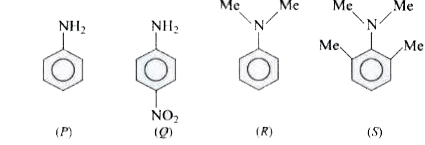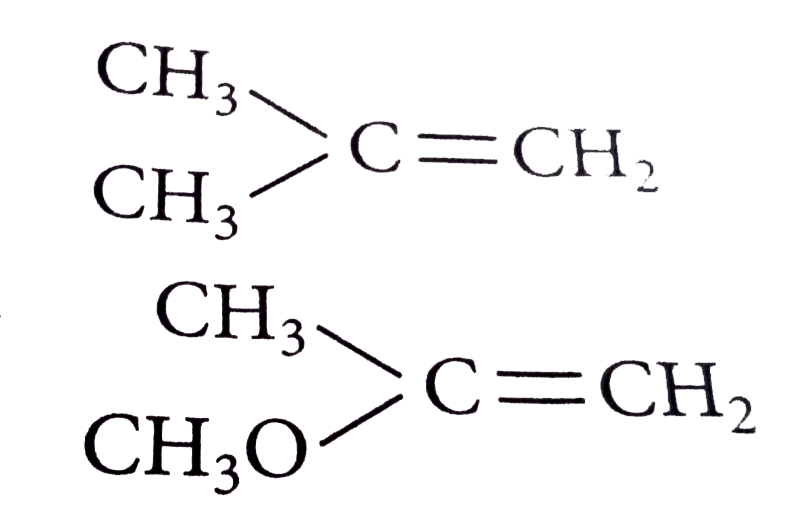Arrange the following compounds in order of increasing reactivity towards HCN :
Acetaldehyde, Acetone, Di-tertiary butyl ketone, Methyl tertiary butyl ketone.
To arrange the compounds in order of increasing reactivity towards HCN (hydrogen cyanide), we need to consider the steric hindrance around the carbonyl group in each compound. The more sterically hindered a compound is, the less reactive it will be towards nucleophiles like HCN.
1. Identify the Compounds:
- Acetaldehyde (CH₃CHO)
- Acetone (CH₃COCH₃)
- Di-tertiary butyl ketone ((CH₃)₃C-CO-(CH₃)₃C)
- Methyl tertiary butyl ketone (CH₃CO-(CH₃)₂C(CH₃)₂)
2. Analyze Steric Hindrance:
- Acetaldehyde: Has minimal steric hindrance as it has only one methyl group attached to the carbonyl carbon.
- Acetone: Has two methyl groups attached to the carbonyl carbon, resulting in moderate steric hindrance.
- Methyl tertiary butyl ketone: Contains a tertiary butyl group and a methyl group, leading to significant steric hindrance.
- Di-tertiary butyl ketone: Has two bulky tertiary butyl groups attached to the carbonyl carbon, resulting in the highest steric hindrance.
3. Order of Steric Hindrance:
- Di-tertiary butyl ketone (most sterically hindered)
- Methyl tertiary butyl ketone
- Acetone
- Acetaldehyde (least sterically hindered)
4. Order of Reactivity Towards HCN:
- Since greater steric hindrance leads to lower reactivity, we can arrange the compounds in reverse order of steric hindrance:
- Acetaldehyde (most reactive)
- Acetone
- Methyl tertiary butyl ketone
- Di-tertiary butyl ketone (least reactive)
Final Order of Increasing Reactivity Towards HCN:
1. Di-tertiary butyl ketone
2. Methyl tertiary butyl ketone
3. Acetone
4. Acetaldehyde
- Acetaldehyde (CH₃CHO)
- Acetone (CH₃COCH₃)
- Di-tertiary butyl ketone ((CH₃)₃C-CO-(CH₃)₃C)
- Methyl tertiary butyl ketone (CH₃CO-(CH₃)₂C(CH₃)₂)
- Acetaldehyde: Has minimal steric hindrance as it has only one methyl group attached to the carbonyl carbon.
- Acetone: Has two methyl groups attached to the carbonyl carbon, resulting in moderate steric hindrance.
- Methyl tertiary butyl ketone: Contains a tertiary butyl group and a methyl group, leading to significant steric hindrance.
- Di-tertiary butyl ketone: Has two bulky tertiary butyl groups attached to the carbonyl carbon, resulting in the highest steric hindrance.
- Di-tertiary butyl ketone (most sterically hindered)
- Methyl tertiary butyl ketone
- Acetone
- Acetaldehyde (least sterically hindered)
- Since greater steric hindrance leads to lower reactivity, we can arrange the compounds in reverse order of steric hindrance:
- Acetaldehyde (most reactive)
- Acetone
- Methyl tertiary butyl ketone
- Di-tertiary butyl ketone (least reactive)
1. Di-tertiary butyl ketone
2. Methyl tertiary butyl ketone
3. Acetone
4. Acetaldehyde
Similar Questions
Knowledge Check
Arrange the following compounds in order of their reactivity toward
 Ai<ii<iiiBi<iii<iiCii<i<IiiDii<iiil<i
Ai<ii<iiiBi<iii<iiCii<i<IiiDii<iiil<iArrange the following compounds in increasing order of acidity :
 AP>Q>R>SBS>Q>R>PCS>R>P>QDR>S>P>Q
AP>Q>R>SBS>Q>R>PCS>R>P>QDR>S>P>QArrange the following compounds in increasing order of basicity :
 AS>R>Q>PBS>R>P>QCP>Q>R>SDR>Q>P>S
AS>R>Q>PBS>R>P>QCP>Q>R>SDR>Q>P>S
Arrange the following alcohols in order of reactivity towards gaseous HBr :

View SolutionArrange the following compounds in the increasing order of their property as indicated:
i. Acetaldehyde, acetone, di-tert-butyl ketone, methyl tert-butyl ketone (reactivity towards HCN).
View SolutionArrange the following compounds in the increasing order of their property as indicated:
i. Acetaldehyde, acetone, di-tert-butyl ketone, methyl tert-butyl ketone (reactivity towards HCN).
ii. CH3CH2CH(Br)COOH,CH3CH(Br)CH2COOH,(CH3)2CHCOOH,CH3CH2CH2COOH (acidic strength).
iii. Benzoic acid, 4-nitrobenzoic acid, 3,4-dinitro-benzoic acid, 4-methoxybenzoic acid (acidic strength).
View SolutionArrange the following compounds in the increasing order in their densities.

View SolutionArrange the following alkenes


in decreasing order of their reactivity towards HBr.
View Solution

